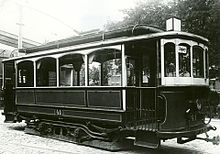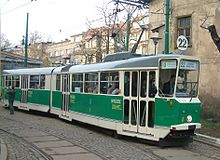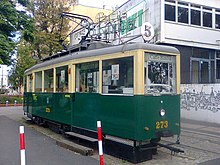Tram Poznan
| Tram Poznan | |
|---|---|
| Combino on line 14 | |
| Basic information | |
| Country | Poland |
| city | Poses |
| opening | July 30, 1888 |
| operator | MPK Poznań |
| Infrastructure | |
| Route length | 65 km |
| Gauge | 1435 mm ( standard gauge ) |
| Power system | 600 V = overhead line |
| business | |
| Lines | 19th |
| Line length | 216 km |
| Cruising speed | 14.8 km / h |
| vehicles | 340 |
| statistics | |
| Passengers | 108.6 million per year (2010) |
| Mileage | 11.4 million km per year |
| Network plan | |
The Poznan tram is operated by Miejskie Przedsiębiorstwo Komunikacyjne w Poznaniu Sp. Z oo (Poznan Municipal Transport Company). Currently (2012) the tram network in Poznan ( Polish : Poznań ) covers a route length of 65 km in standard gauge , on which 20 lines operate. A special feature is the tram to the Jana III Sobieskiego settlement, which has a few branches in the city center. In the local dialect, the tram is called Bimba (Pl. Bimby).
history
Since the Congress of Vienna in 1815, Poznan had been the capital of the province of the same name in the Kingdom of Prussia and as such was part of the German Empire from 1871 . During the Wielkopolska Uprising of 1918 and 1919, great pressure was exerted to join the province to Poland , which was established under international law in the 1919 Versailles Peace Treaty . The development of public transport in the city must be viewed in the light of this history. Until the First World War it was built, operated and equipped with vehicles with German funds. From 1939 to 1945 Posen was occupied by the Germans, initially as part of the Posen military district , from October 26, 1939, without recognition by the Polish government, annexed as the new Reichsgau Posen (from January 29, 1940 then under the name Reichsgau Wartheland ). With the Soviet occupation of the Poznan region in January and February 1945, the German occupation ended before the end of World War II . Today's Greater Poland Voivodeship roughly covers the area of the old Poznan Province.
Horse tram (1880–1898)
The Berlin entrepreneurs Otto Reymer and Otto Masch , who operated the Wilmersdorf-Schmargendorfer steam tram that opened in 1888 , introduced the first horse-drawn tram in Poznan. After Reymer & Masch had received the concession from the city, construction began and on July 30, 1880 the first line ran from the main train station via St.-Martin-Strasse, Ritterstrasse and Wilhelms-Platz to the Altmarkt. A branch line from Grosse Gerberstrasse also went into operation. After a few weeks, the company was on the verge of bankruptcy: there were few passengers and the branch route proved to be a failure. In addition, the horse-drawn tram was boycotted by the Polish residents of the city, as the wagons were only labeled in German. The company was bought by the Poznan Horse Railway Company , which at the same time received a concession to operate throughout the city. At that time, 50 cars were in use. Business then went better and in 1896 two new lines were put into operation: one from the Altmarkt via Breslauer Straße, Petriplatz and Halbdorf-Straße to Wildaer Tor and a second from Marienstraße through Tiergartenstraße, Hedwigstraße to Jersitzer Markt. After a year, this route was extended via Feldstrasse to the chemical plant. Both new routes were already prepared for electric trams, as they were based on a strong superstructure to carry heavier cars. The largest stretch of the horse-drawn tram network was 37 kilometers.
Electric tram
On March 6, 1898, the horse-drawn trams were replaced by electric trams. Three lines were put into operation, which were marked with colors:
- White - the replacement of the horse-drawn tram line from the main train station via the Altmarkt to Cathedral Island
- Red - from Jersitzer Markt via Hedwigstrasse, Tiergartenstrasse, St. Martin Strasse and then along the old horse-drawn tram route over the Altmarkt to Wildaer Tor,
- Yellow - from the main train station like the white line, but only as far as Große Gerberstraße.
A fourth line went into operation in April 1898:
- Green - from the Altmarkt via St. Martin Straße and Glogauer Straße to Górczyn
The fare was 10 to 20 pfennigs , after 11 p.m. double the fare was charged. The roller pantograph was used for the power supply . Before the First World War, various network extensions were put into operation, for example to the communal slaughterhouse, to the court, to the Eichwald-Tor and to the districts of Schrodka, Solacz and Dembsen. New routes in the city center had to relieve the heavily demanded connections. New bridges were built over the railway: the theater bridge and the station bridge.
In the interwar period, the districts of Golęcin, Dębina, Ogrody, Grunwald and Winiary were connected to the tram network. The route to Dębiec has been extended. At the same time, some routes were relocated from the narrow streets in the old town to today's routes because the railways there were too much obstructed. Because of the global economic crisis from 1929, a planned route to Główna was not built and instead a trolleybus line that could be realized at a lower cost was used on this route .

After the Second World War
After the Battle of Poznan , 50 percent of the city was in ruins; the inner city was almost 90 percent destroyed. Almost all of the tracks were badly damaged and lay under a meter of rubble and rubble, the entire overhead line had been removed and removed or destroyed, and almost the entire fleet of cars was stolen, burned or unusable. Two years after the end of the war, tram traffic was almost completely restored to its old level. At the same time, the overhead line was constructed in such a way that it was suitable for the use of pantographs . The residential and industrial areas in the east of the Warta were not yet accessible by tram. Some routes in the city center were not rebuilt and instead a new route was built across Bernardyński Square. Only in 1952 could the connection to the eastern part of the city be re-established with the opening of the Marchlewski Bridge (today: Królowej Jadwigi Bridge). In the years that followed, many new tram lines were built to connect the city center with the numerous new residential areas:
- from 1955 to 1957 a stretch along Marchlewskiego Street (today: Królowej Jadwigi Street),
- from 1968 to 1973 a section on Przybyszewskiego, Reymonta and Hetmańska streets,
- from 1974 to 1977 from Wielkopolski Square via Małe Garbary Street, Estkowskiego Street to the Śródka roundabout and
- from 1983 to 1985 from Lecha via Jedności Słowiańskiej Street (today: Chartowo and Żegrze) to Hetmańska Street.
Finally, the residential and industrial areas furthest from the city were connected to the tram network:
- between 1949 and 1950 route to the public cemetery in Junikowo
- between 1957 and 1964 to Wilczak Street (the branch to Serbska Street was added in 1974)
- 1955 from Rataje to the Stomil tire factory in Starołęka, this route was extended to Poznań Starołęka station in 1967.
- 1959 to Zawady via Śródka with a branch to the Warszawskie settlement, in 1974 extended to Miłostowo
- 1979 to Chartowo and the Lecha settlement
- 1980 to Winiary and to Piątkowska Street
Of great importance for the tram system was the strategy adopted by the city administration in 1994 that the basis of public city transport should consist of a network of high-speed tram connections. One consequence of this is that when roads, crossings and squares are converted, a separate track structure is created for the railway and traffic light priority circuits are installed.
Current line network
| line | map | route | length | Travel time | Hold | vehicles | comment |
|---|---|---|---|---|---|---|---|
| 0 |  |
Gajowa ↔ Gajowa | 9 km | 40 min | 4th | Museum car | Tourist line |
| 1 |  |
Węgorka ↔ Franowo | Konstal 105N and derived from it, Duewag GT8 | ||||
| 2 |  |
Ogrody ↔ Dębiec | 9.9 km | 37 min | 20th |
Moderus Alfa , Moderus Beta , Duewag GT8, Siemens Combino , Konstal 105N and derivatives thereof |
|
| 3 |  |
Wilczak ↔ Zawady | 11.7 km | 35 min | 23 |
Konstal 102Na , Konstal 105N, Duewag GT6, Duewag GT8, Duewag GT8ZR, Beijnes 3G |
Only runs on working days. Does not operate from July 1st to August 31st. |
| 4th |  |
Połabska ↔ Starołęka | 12.9 km | 32 min | 29 | Konstal 105Na, Moderus Beta, Duewag GT8 |
|
| 5 |  |
Górczyn ↔ Stomil | 26.6 km | 42 min | 27 |
Solaris Tramino , Duewag GT8 |
|
| 6th |  |
Węgorka ↔ Miłostowo | 14.4 km | 36 min | 26th | Moderus Alfa, Siemens Combino, Solaris Tramino, Konstal 105N and derivatives thereof |
|
| 7th |  |
Ogrody ↔ Zawady | 11.5 km | 35 min | 21st |
Duewag GT8, Duewag GT8ZR, Moderus Beta |
|
| 8th |  |
Ogrody ↔ Miłostowo | 12.5 km | 42 min | 23 | Konstal 105Na, Moderus Beta, Siemens Combino |
|
| 9 |  |
Piątkowska ↔ Dębiec | 14.9 km | 38 min | 26th | Duewag GT8, Siemens Combino |
|
| 10 |  |
Połabska ↔ Dębiec | 8.8 km | 30 min | 20th | Konstal 105Na and derived therefrom, Moderus Alfa, Duewag GT8, Siemens Combino, Solaris Tramino |
|
| 11 |  |
Piątkowska ↔ Zawady | 14 km | 35 min | 24 | Duewag GT8 and derived from it, Konstal 105N and derived from it, Moderus Alfa, Siemens Combino |
|
| 12 |  |
Settlement Jana III Sobieskiego ↔ Starołęka | 14.5 km | 37 min | 22nd | Konstal 105Na and derived therefrom, Moderus Alfa, Siemens Combino, Modertrans / Tatra RT6 MF06 AC , Solaris Tramino, Tatra RT6N1 |
|
| 13 | 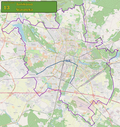 |
Węgorka ↔ Starołęka | 14.7 km | 47 min | 29 | Konstal 105N and derived, Tatra RT6N1, Modertrans / Tatra RT6 MF06 AC |
|
| 14th |  |
Settlement Jana III Sobieskiego ↔ Górczyn | 10.3 km | 28 min | 16 |
Siemens Combino, Solaris Tramino |
|
| 15th |  |
Settlement Jana III Sobieskiego ↔ Węgorka | 14 km | 27 min | 21st | Konstal 105N and derived therefrom, Solaris Tramino, Moderus Alfa |
|
| 16 | 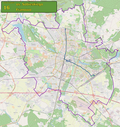 |
Settlement Jana III Sobieskiego ↔ Franowo | 34 min | 26th | Konstal 105N and derived from it, Siemens Combino, Solaris Tramino |
||
| 17th | 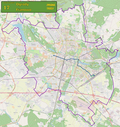 |
Ogrody ↔ Starołęka | 15.6 km | 29 min | 28 | Konstal 105N and derived therefrom, Moderus Alfa, Moderus Beta |
|
| 18th |  |
Franowo ↔ Starołęka | Duewag GT8, Siemens Combino, Tatra RT6N1 |
Does not operate from July 1st to August 31st. | |||
| 26th |  |
Settlement Jana III Sobieskiego ↔ Gwarna | 9.2 km | 16 min | 10 | Moderus Alfa, Siemens Combino, Solaris Tramino, Konstal 105Na and derived therefrom, Duewag GT8, Duewag GT8ZR |
Reinforcement line. Only runs during rush hour . |
| N21 |  |
Settlement Jana III Sobieskiego ↔ Marcinkowskiego | 10.7 km | 16 min | 16 | Duewag GT8, Solaris Tramino |
Night line. Does not run in the night from Monday to Tuesday. |
Light Rail (Poznański Szybki Tramwaj)
An important innovation was achieved on February 1, 1997 with the commissioning of a 6.1 km long light rail line to the north of the city. The city administration wanted a fast tram to the north as early as the 1920s, when the Winogrady and Piątkowo districts were already under construction. In the 1970s, the plan came back on the agenda in a kind of premetro, which was to connect the north via the city center with the south. This idea was inspired by the building of the Premetro Brussels . The construction of the north branch began in 1982 with a first extension to Murowana Gośliny, but had to be stopped due to financial problems. An overpass at the Lechicka tram depot is still a witness of the plan to build an underground connection to the city center, but this overpass was not needed in the final planning. One stop on the flyover, planned as PST Wielkopolska, has been canceled.
The new light rail line, called Pestka , connects the city center with the satellite city Jana III Sobieskiego in the north of Poznan. The route runs entirely on its own track in a trough and is free of intersections. The stations are light rail-like, but with low platforms. At the height of Roosevelt Strasse, the route merges into the normal tram network and branches into a number of lines (2012: 12, 14, 15, 16 (formerly D) and 26) in different directions. A night line (N21, formerly N14) connects the suburbs with the city center every 40 minutes at night. The new light rail line is planned for a capacity of 6000 passengers per direction and hour. It is served by four lines and one HVZ line. The route has six stops, all of which are marked with a color, and buses run from 5 of these stops to the more remote villages and settlements.
The future expansion, which will be the first to be tackled, is the replacement of the street-level section from Roosevelt-Straße with a line running along the cut of the railway to the main station. This connection will be implemented at today's bridge over the Poznańska stop. An extension from there to St. Głogowska, today's terminus of lines 5, 8 and 14, is being planned. Two stops are to be built, and the route is then to temporarily end in the station building. An extension to the university campus is planned in the north, but this is still in the negotiation stage. Another development is the construction of a light rail over a new route to the east of the city. This project was put into operation as Ratajski Szybki Tramwaj on August 14, 2007. The new line connects Wiosny Ludów Square via Podgórna Street, Dowbora Muśnickiego Street, Mostowa Street, etc. Rocha Bridge and Kórnicka Street with Jana Pawła II Street and then further into the settlement. It is used by lines 5, 13 and 16, with line 16 being the only one serving both the northern and eastern light rail lines.
Expansion plans
There are several expansion plans for the Poznan tram network for which funding is sought. Some large residential areas such as Dębiec in the south, Podolany in the northwest and Wola and Smochowice in the west are to be connected to the tram. The plans and ideas include:
- Extension of the route from the Lecha settlement via Piaśnicka Street to the Franowo industrial area ([1] on the map),
- Extension from the Ogrody terminus via Dąbrowskiego Street to Polska Avenue ([2] on the map),
- Extension from the Zawady terminus via Zawady Street and Główna Street to Poznań Wschód Railway Station ([3] on the map),
- Extension from Dębiec via the 28 June 1956 road to the Dębina settlement ([4] on the map),
- a new route across Ratajczak Street, Cyryl Ratajski Square, Solna Street and Nowowiejskiego Street ([5] on the map);
- a new route to the Kopernika settlement via Arciszewski Street and Pogodna Street ([6] on the map),
- a new route from Ogrody via Szpitalna Street and Grochowska Street towards Junikowo ([7] on the map),
- Junction at Żegrze roundabout to Falista street ([8] on the map);
- Branch from the Male Garbary stop via Szelągowska Street to the Wilczak terminus and then via Naramowickiej Street to the large residential area of Naramowice ([9] on the map). The European Union is providing money for the section from Wilczark to Naramowice .
vehicles
history
Poznan has an eventful history in terms of the trams used.
- The horse-drawn tram drove with two-axle wagons whose entry platforms were open. The construction took place at Herbrand in Cologne.
- The first electric trams were built by Bergische Stahlindustrie, while the electrical equipment was supplied by Union-Elektricitäts-Gesellschaft Berlin. The wagons were given the numbers 1 to 15 and had open platforms and three arched windows on each side. In the 1920s they were already retired.
- The tram factory Carl Weyer & Co. in Düsseldorf built the Type W for Posen. A total of 37 copies were delivered between 1904 and 1911 and numbered 39–52 and 70–92. In 1937 they were renumbered into a continuous series: 47-98. In 1938, 20 of these cars were fitted with closed platforms and sliding doors between them and the interior of the car. In 1943, the remaining cars were converted to work cars and after the Second World War they were still in service in Gorzów Wielkopolski (German: Landsberg an der Warthe). These panels were longer than the first series, they had four large curved side windows.
- The type L was built by Linke-Hofmann in Breslau and delivered to Poznan in 1914 and 1915. These large two-axis railways with four very large side windows had closed platforms from the start and were numbered from 53 to 65 (after 1941 80-92). After the Second World War, these cars were completely rebuilt and given a steel body. In the 1950s they were sold to Jelenia Góra (German: Hirschberg im Riesengebirge).
- The type R, built by the Ringhoffer works in Prague-Smichov with electrical equipment from Siemens-Schuckertwerke or Brown, Boveri & Cie. , was put into service from 1924 to 1926 and was numbered 66 to 69 and 93 to 103. (After 1937 31–45 and after 1941 100–114). These cars were very similar to the type M (series 4001-4150) of the Vienna tram and got a new substructure based on the Konstal type N after the Second World War . In the 1960s they were retired.
- The Type Z, built in 1929 by L. Destinationsiewski and Fitzner-Gamper in Sanok , was put into service under numbers 1 to 15 and 104 to 108 (after 1937 1–20 and after 1941 120–139). After the war they were restored and in the 1960s some were converted into sidecars . These cars were very similar to the aforementioned Viennese railcars. The types R and Z had a steel body from the start.
- The Type C was produced in 1937 by the local wagon maker Cigielski in a series of ten: Numbers 21 to 30, later numbered 140 to 149 and after the war 141-150. In 1969 these large steel railcars were converted into sidecars. These tracks were very similar to the aforementioned Viennese type, but were longer and had a different front.
During the Second World War, surplus cars from German companies came to Posen via the Reichsleistungsgesetz to meet the demand there. Two railcars came from the Dresden tram (types A1 / 3), five from Karlsruhe (in Posen: No. 40-44), two Z1t cars from Hamburg (built by the vehicle workshop Falkenried ) and four cars from Berlin (in Posen: No. 40-44) 405 and 406 and nos. 407 and 408 ). All cars were two-axle and built around 1900.
- The first war tram cars made by the Fuchs company in Heidelberg reached Posen in 1944, while they were actually intended for Vienna. Because of the war situation, however, they were diverted to Poznan. Five of these cars had neither electrical equipment nor engines and were built using old chassis. It was not until the mid-1960s that these cars got improved engines and were converted into one-way cars.
After the Second World War, some used vehicles were bought in order to solve the bad situation caused by the large number of damaged and destroyed cars.
- Trains of the Dessau S1 type came from Stettin and were given the numbers 2 to 8. They were traditional two-axle wagons with four side windows. They were shut down in the 1960s.
- Also from Szczecin came Wismar S2D trains with a central entry and a low-floor central section, which are similar to the four-axle vehicles from Rotterdam . They were a little shorter and lighter and had two single-axle bogies. These cars, built by Linke-Hofmann, were given the numbers 9 to 15 and were converted into sidecars in the 1950s. In the 1970s they were sold as garden sheds.
- In 1951 the first war tramcars manufactured by Konstal were delivered: the type N. The first 30 railcars were given the numbers 161 to 190, the remaining 18 191-209. At the beginning of the 1960s, they were converted into one-way vehicles and later given to Warsaw .
- From 1957 the Konstal railways of the types 4N and 4N1 came to Posen (No. 210–262), which were built in large numbers in Poland and which actually became the Polish standard wagons after the war. In the mid-1960s they were passed on to Warsaw.
- 71 Konstal 102N (a) single articulated trams were delivered between 1969 and 1972 (No. 1–71). Since the cars were technically worn out, they were already parked in the 1990s.
- Between 1991 and 1995 Posen took over 20 used double-joint eight-axle vehicles from Amsterdam . These were types 1G and 2G railways, which had been built by Beijnes in Haarlem between 1957 and 1959 (series 551–385, later 851–887). The tracks were painted green and yellow and retained their characteristic large line film boxes. Since some railways were needed as spare parts donors to keep the others in operation, eleven of them were used very regularly. These kept their own car numbers in Poznan. In 2003, a part of the 3G series from 1960 with the numbers 602 to 634 came to Poznan to replace the 1G and 2G. These received numbers from the 800 block. In the meantime, these railways called Holendry from the first donation in 2011 went out of service. Car 805 was preserved as a museum car.
Museum car
In contrast to many other Polish cities, which can hardly present vehicles from the time before the Second World War as museum cars, in Poznan there are:
- A Herbrand -B3 / HO horse-drawn tram.
Some pre-war railcars awaiting restoration:
- A railcar from Carl Weyer & Cie. from Düsseldorf, type W, 1904/11 (No. 305)
- A railcar from 1930, type Wismar Niesky S2D, which is to get the number 423. This train came used from Stettin in World War II and was found in an allotment garden in Suchy Las. It is a rare, elegant center entry model with a low car floor.
- A Fuchs KSW car (No. 158) that is in very poor condition.
- A Konstal-N railcar (No. 2024).
For museum trips are available:
- A Konstal 4NJ railcar (No. 602) and a 4D sidecar from 1950–1970.
- A Konstal 102N single-joint track from the 1960s with a characteristic forward windshield (No. 1).
- Two four-axle Konstal 105N railcars with the numbers 193 and 194.
- A GT8 Duewag double articulated eight-axle vehicle, which is used as No. 608 in the Rheinbahn paint scheme on tourist line 0.
Today's fleet
- Several Duewag standard cars were sold to Poznan between 1995 and 2005. A GT6 in 1996, 57 GT8s from the Düsseldorf tram and a GT8-ZR (bidirectional version) found their way to Poznan. Her nickname is Helmut .
- 206 four-axle Konstal 105Na railcars, built between 1979 and 1992. Their nickname is Aquarium .
- 40 Moderus Alfa cars. These are modernized Konstal 105N wagons that have been given a new interior, new electrical equipment and a renewed exterior design.
- 8 Moderus Beta cars, consisting of two old Konstal 105N trams, connected to a low-floor middle section. These wagons went into operation in 2011 after an extensive renovation that cost 2.9 million zlotys .
- 14 five-part Siemens Combino lifts, numbered 501 to 514, were purchased in 2004. Because of a design flaw that led to problems across Europe - including in Potsdam - they were revised by the manufacturer. Because of the major problems, the tram company decided not to place a follow-up order for this type.
- 10 Tatra RT6N1 trams (401-410). These trams were specially designed for the commissioning of the light rail in 1997. They show external similarities with the first new low-floor trams for Geneva . The susceptibility of these cars to malfunctions proved to be very high and they were relegated to other tram lines fairly quickly. The RT6N1 were rebuilt from 2012 to 2015 to increase their reliability.
- Five-part, 32-meter-long Solaris Tramino S105P low-floor trams, with 3 two-axle bogies, purchased in 2011. This is an order worth 342 million złoty for 40 cars with an option for 20 more. The first 45 cars were to be used in the 2012 European Football Championship . These modern trams from an original bus manufacturer are 2.4 meters wide and can carry a maximum of 230 passengers. The doors are 1.5 meters wide to speed up passenger changes. A reminiscence of the old line number plates was brought about by these new cars, just like the Moderus Alfa and Beta trains, bearing a round matrix display for the line number on the roof above the windshield.
literature
- Robert Schwandl: Tram Atlas Poland Poland . 1st edition. Robert Schwandl Verlag, Berlin 2017, ISBN 978-3-936573-50-3 , pp. 82–89 , chapter Poznań (German, English).
Web links
- Website of the operator MPK
- Schematic route network plan (PDF; 1.2 MB)
- Vehicle overview: http://www.mpk.poznan.pl/o-mpk/tabor/148-tramwaje-historyczne
- Museum vehicles: http://www.kmps.org.pl/tabor.php
- ↑ Poznań. Jest dotacja dla tramwaju na Naramowice . Transport Publiczny, December 28, 2017, accessed December 30, 2017



